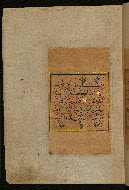Home > Digitized Walters Manuscripts
This document is a tranformation of a TEI P5 XML manuscript description incorporating images. If you have trouble reading special or non-Latin characters on this page, please make sure you have appropriate Unicode fonts installed and an up-to-date web browser.
Walters Ms. W.559, Koran
Browse images (Browse images in a new window) | TEI in XML format
W.559
Koran
Vernacular: القرآن
This illuminated copy of the Qur’an was excecuted in Shaʿbān 723 AH / 1323 CE by Mubārakshāh ibn Quṭb, honored with the epithet zarrīn qalam (golden pen). Mubārakshāh ibn Quṭb was one of the six pupils of the illustrious calligrapher Yāqūt al-Mustaʿṣimī (d. 698 AH / 1298 CE). This manuscript, with a colophon signed and dated by Mubārakshāh (fol. 432a), was produced in Ilkhanid, Iran. It opens with a double-page illuminated frontispiece of geometric design painted in blue, black, gold, and green (fols. 1b-2a). Additional ornamentation includes verse markers and textual dividers. The Qur'anic text is written in naskh script in black ink with chapter headings in gold tawqī‘ outlined in black. The Persian interlinear translation in red naskh likely belongs to a later stage of the manuscript's history, when it was rebound and furnished with new margins. The black goatskin binding has a gold-tooled design of a central lobed medallion, pendants, and cornerpieces with doublures of brown leather and filigree decoration. It probably dates to the tenth century AH / sixteenth CE.
Shaʿbān 723 AH / 1323 CE
Iran
As-written name: Mubārakshāh ibn Quṭb
Name, in vernacular: مباركشاه بن قطب
Note: Nicknamed zarrīn qalam (golden pen), Mubārakshāh was one of the six pupils of the illustrious calligrapher Yāqūt al-Mustaʿṣimī (d. 698 AH / 1298 CE).
Book
Scriptural
The primary language in this manuscript is Arabic. The secondary language of this manuscript is Persian.
- Transliteration: katabahu al-faqīru ilá Allāhi taʿālá /1/ Mubākshāhu ibn Quṭbin ghafara Allāhu /2/ dhunūbahumā wa-satara ʿuyūbahumā fī Shaʿbāni /3/ sanata thalāth wa-ʿishrīna wa-sabʿa miʾatin /4/ ḥāmidan li-Llāhi taʿālá ʿalá niʿamihi wa-muṣalliyan /5/ ʿalá nabīyihi Muḥammadin wa-ālihi al-ghurari al-kirāmi /6/ al-ṭayyibīna al-ṭāhirīna wa-musalliman taslīman /7/
- Comment: Gives the name of the calligrapher Mubākshāh ibn Quṭb and the date of copying
Paper
Dark cream laid Persian paper inlaid into later margins, probably in the tenth century AH / sixteenth CE
Foliation: i+432+i
Catchwords: None
Comments:
13.5 cm wide by 18.5 cm high
6.5 cm wide by 11.0 cm high
- Columns: 1
- Ruled lines: 13
- Framing lines in dark blue, black, and gold
- Title: al-Qurʾān
- Scribe: Mubārakshāh ibn Quṭb
- Hand note: Written in small naskh in black ink; sūrah headings in gold tawqīʿ outlined in black; naskh in red ink for interlinear Persian translation
- Decoration note: Double-page frontispiece (fols. 1b-2a); double-page opening decoration (fols. 2b-3a); illuminated rosettes with colored dots for verse markers; frequent marginal medallions for verse counts of ten and textual dividers, such as juzʾ and rubʿ; polychrome frame
fol. 1b:

- Title: Right side of a double-page illuminated frontispiece
- Form: Frontispiece
- Label: This double-page illuminated frontispiece is comprised of two rectangles surrounded by a trefoil border in grisaille. The inner border is gold strapwork with blue squares. The central area is an intricate design of geometric forms and arabesques in blue, black, gold, and green.
fol. 2a:

- Title: Left side of a double-page illuminated frontispiece
- Form: Frontispiece
- Label: This double-page illuminated frontispiece is comprised of two rectangles surrounded by a trefoil border in grisaille. The inner border is gold strapwork with blue squares. The central area is an intricate design of geometric forms and arabesques in blue, black, gold, and green.
fol. 2b:

- Title: Incipit page for chapter 1 of the Qur'an
- Form: Incipit
- Text: Surat al-fātiha
- Label: This opening page is inscribed with the first chapter of the Qur'an (Sūrat al-fātiḥah). The Qur'anic text is written in black naskh, and the Persian interlinear translation is in red.
fol. 3a:
The binding is not original.
Probably tenth century AH / sixteenth CE; black goatskin (with flap); gold-tooled central lobed oval with pendants and cornerpieces decorated with floral and vine motif; gold-tooled frame; doublures of brown leather with a lobed oval, pendants, and cornerpieces, all with filigree decoration on a dark blue ground
Walters Art Museum, 1931, by Henry Walters bequest
Principal cataloger: Gacek, Adam
Catalogers: Landau, Amy; Smith, Sita
Copy editor: Bockrath, Diane
Conservators: Jewell, Stephanie; Quandt, Abigail
Contributors: Barrera, Christina; Emery, Doug; Herbert, Lynley; Noel, William; Simpson, Shreve; Tabritha, Ariel; Toth, Michael B.; Valle, Chiara
The Walters Art Museum
Licensed for use under Creative Commons Attribution-NonCommercial-ShareAlike 3.0 Unported Access Rights, http://creativecommons.org/licenses/by-nc-sa/3.0/legalcode. It is requested that copies of any published articles based on the information in this data set be sent to the curator of manuscripts, The Walters Art Museum, 600 North Charles Street, Baltimore MD 21201.
